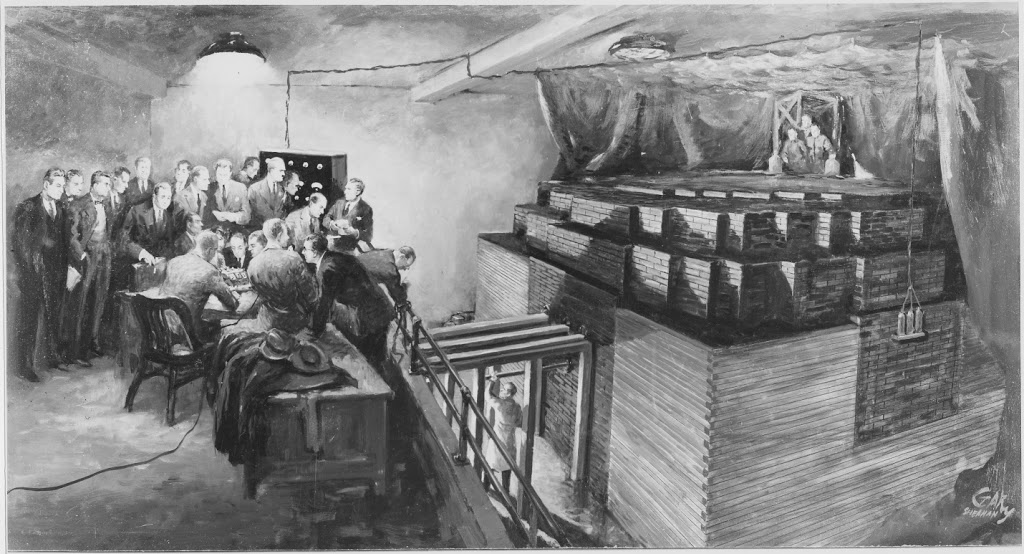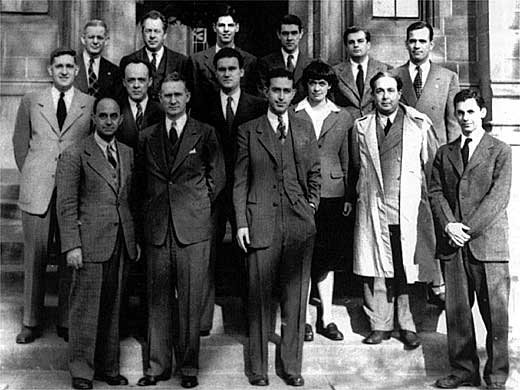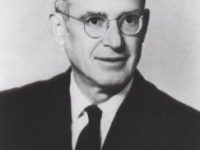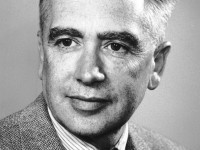
Time: 3:22 p.m, December 2, 1942. Place: Racquets Court under West Stands of Stagg Field,
University of Chicago. Depiction of scientist(s) observed the world’s first nuclear reactor
(CP-1) as it became self-sustaining, National Archives Identifier 542144
On December 2, 1942, during the Manhattan Project, a team led by Italian born physicist Enrico Fermi initiated the first self-sustaining nuclear chain reaction in the Chicago Pile-1 (CP-1), the world‘s first human-made nuclear reactor, and initiated the so-called atomic age. CP-1 was built on a rackets court, under the abandoned west stands of the original Alonzo Stagg Field stadium, at the University of Chicago.
Nuclear Chain Reaction and the Atomic Bomb
Soon after the German physicists Otto Hahn and his assistant Fritz Strassmann were able to show that nuclear fission can be shown back in 1938,[4] Hahn’s other assistant Lise Meitner,[5] who was forced to leave Germany into emigration, realized that this might lead to a self-sustaining chain reaction, where incredible amounts of energy must be set free. And with this hugh amount of energy being set free in almost an instant, also a nuclear bomb with immense destructiveness became possible. When in 1939 World War II began, also scientists on the other side of the Atlantic foresaw this possibility. It was famous Albert Einstein, who had emigrated from Germany and his former student, Hungarian-born physicist Leo Szilard,[7] who attempted to alert Washington of ongoing Nazi atomic bomb research. Together with other scientists they “regarded it as their responsibility to alert Americans to the possibility that German scientists might win the race to build an atomic bomb, and to warn that Hitler would be more than willing to resort to such a weapon.“

Chicago Pile One scientists at the University of Chicago on December 2, 1946, the fourth anniversary of their success.
Back row, from left: Norman Hilberry, Samuel Allison, Thomas Brill, Robert Nobles, Warren Nyer, and Marvin Wilkening.
Middle row: Harold Agnew, William Sturm, Harold Lichtenberger, Leona Woods and Leó Szilárd.
Front row: Enrico Fermi, Walter Zinn, Albert Wattenberg and Herbert L. Anderson.
The Manhattan Project
This was the starting point of the Manhattan Project, in which the US aimed at developing an atomic bomb during world war II. While the Manhattan Project began modestly in 1939, but grew to employ more than 130,000 people and cost nearly US$2 billion (roughly equivalent to $25.8 billion as of 2012). Part of that project was also a project, code-named the Metallurgical Laboratory, that was charged with creating controlled, self-sustaining, nuclear reaction. Actually the place, where the first reactor should be constructed was a new laboratory at Argonne Forrest near Chicago. But delays in establishing Argonne National Laboratory led to the construction of the first nuclear reactor beneath the bleachers of Stagg Field at the University of Chicago.
Chicago Pile 1
The reactor was a pile of uranium and graphite blocks, assembled under the supervision of the renowned physicist Enrico Fermi, in collaboration with Leó Szilárd.[7] It contained a critical mass of fissile material, together with control rods. The shape of the pile was intended to be roughly spherical, but as work proceeded Fermi calculated that critical mass could be achieved without finishing the entire pile as planned. The pile consisted of uranium pellets as a neutron-producing “core”, separated from one another by graphite blocks to slow the neutrons. Fermi himself described the apparatus as “a crude pile of black bricks and wooden timbers.” The controls consisted of cadmium-coated rods that absorbed neutrons. Withdrawing the rods would increase neutron activity in the pile, leading to a self-sustaining chain reaction. Re-inserting the rods would dampen the reaction.
On December 2, 1942, CP-1 was ready for a demonstration. Before a group of dignitaries, a young scientist named George Weil worked the final control rod while Fermi carefully monitored the neutron activity. The pile reached “criticality” or a self-sustaining reaction at 15:25. Fermi shut it down 28 minutes later. Physicist Arthur Compton, Chairman of the National Defense Research Committee, reported the success to Washington, D.C., by a coded phone call, saying, “The Italian navigator [Fermi] has just landed in the new world.“
The Day Tomorrow Began: The Story of Chicago Pile 1, the First Atomic Pile – 1 of 2, [9]
References and Further Reading:
- [1] Chicago Pile One at Argonne National Laboratory
- [2] Bethe, Hans A. (1991). The Road from Los Alamos. New York: Simon and Schuster. ISBN 0-671-74012-1.
- [3] Hewlett, Richard G.; Anderson, Oscar E. (1962). The New World, 1939–1946. University Park: Pennsylvania State University Press. ISBN 0-520-07186-7
- [4] Otto Hahn – the Father of Nuclear Chemistry, SciHi Blog
- [5] Lise Meitner – The Misjudged Genius, SciHi Blog
- [6] Now I am become Death, the Destroyer of Worlds, SciHi Blog
- [7] Leo Szilard and the Atomic Bomb, SciHi Blog
- [8] Chicago Pile-1 at Wikidata
- [9] The Day Tomorrow Began: The Story of Chicago Pile 1, the First Atomic Pile – 1 of 2, Nuclear Engineering at Argonne @ youtube
- [10] Timeline of the Manhattan Project, via Wikidata






thanks for share.554
Pingback: Whewell’s Gazette: Year 2, Vol. #21 | Whewell's Ghost
Pingback: Whewell’s Gazette: Year 3, Vol. #16 | Whewell's Ghost